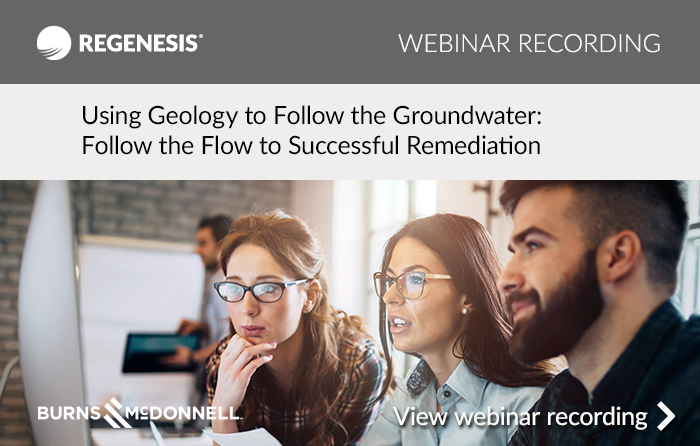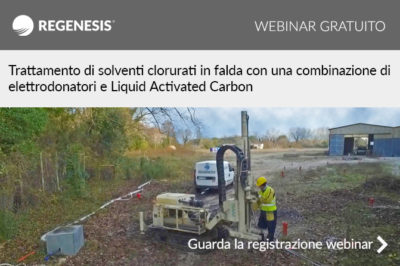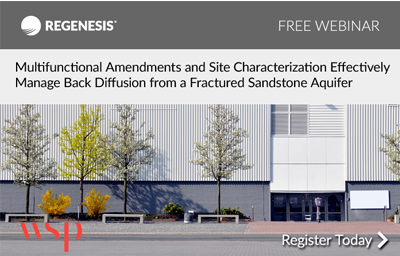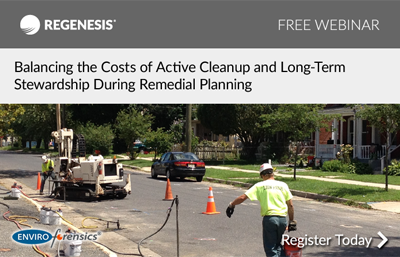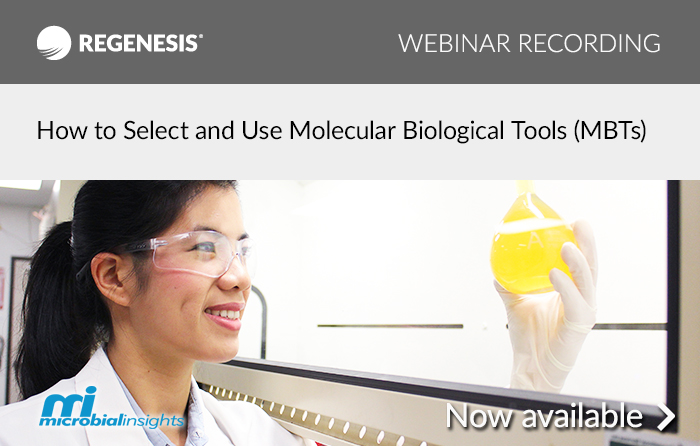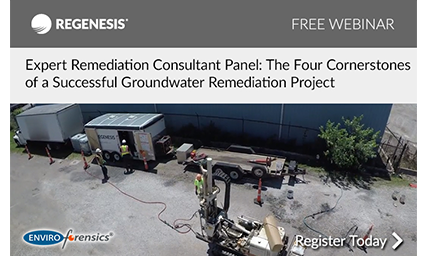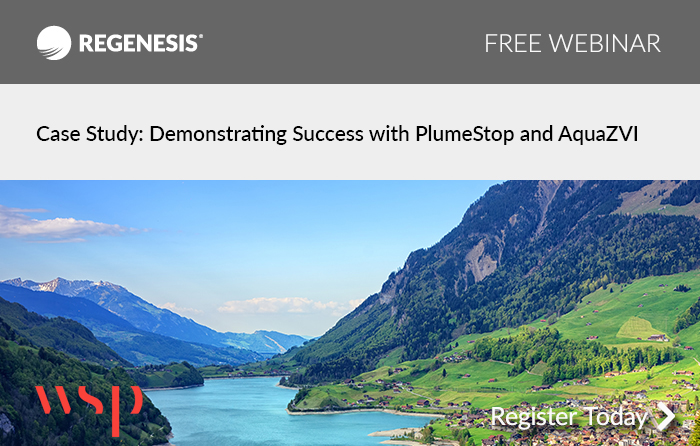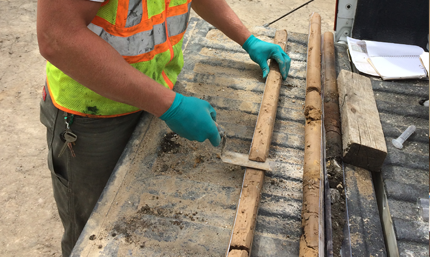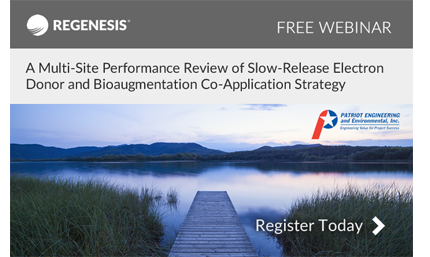Using Geology to Follow the Groundwater: Follow the Flow to Successful Remediation
First broadcast: November 15, 2017
Speakers: Rick Cramer, PG, CA Remediation Department Manager at Burns & McDonnell and Craig Sandefur Vice President of Remediation Applications Development at REGENESIS
Recording Available| In this webinar we are pleased to have as a special guest speaker Rick Cramer, CA Remediation Department Manager at Burns & McDonnell(USA). His presentation will demonstrate Environmental Sequence Stratigraphy (ESS), an established methodology that significantly reduces the uncertainty and provides the framework for characterising contaminant migration pathways and defining the conceptual site model (CSM).
Examples will be presented that show the efficacy of ESS as a critical path to complex site investigation and remediation. The methodology has been successfully applied at numerous complex contaminated groundwater sites throughout the US, including over 25 US Department of Defense (DoD) facilities. The case studies will provide examples of best practices in applying geology to CSMs and provide “rules of thumb” to test the efficacy of your CSM.
Certificates of Attendance can be made available (that may contribute to CPD). Please email your request for you and your colleagues to europe@regenesis.com.
View webinar recording
Demonstrating Contaminant Biodegradation in Conjunction with PlumeStop®Liquid Activated Carbon™
First broadcast: July 25, 2017
Speakers: Dora Taggart President, Microbial Insights, Inc.
Recording Available | PlumeStop Liquid Activated Carbon is an innovative remediation technology with the potential to rapidly reduce dissolved contaminant concentrations, decrease risk of migration, and provide a means of addressing contaminant back-diffusion. As is demonstrated in this webinar, the technology permits and promotes biodegradation to achieve not just containment but effective contaminant destruction as a long term solution.
In this webinar we are pleased to have as a special guest speaker Dora Taggart, President of Microbial Insights, Inc. Her presentation focused on case studies where molecular biological tools (qPCR and QuantArray®) were used to investigate the impact of PlumeStop injections on key halorespiring bacteria and anaerobic biodegradation at chlorinated solvent sites. The full recording is now available here.
View webinar recording
Trattamento di solventi clorurati in falda con una combinazione di elettrodonatori e Liquid Activated Carbon
First broadcast: July 17, 2017
Speakers: Marcello Carboni (Mediterranean District Manager) and Paola Goria (Technical Service Manager)
Questo webinar è stato presentato in diretta il 12 luglio 2017. L’Ing. Marcello Carboni e l’Ing. Paola Goria hanno presentato un caso di studio italiano relativo ad un sito complesso di grandi dimensioni con una contaminazione da solventi clorurati nell’acquifero superficiale.
Il progetto è stato modulato per fasi, di cui la prima è consistita in un intervento di biodegradazione anaerobica potenziata mediante l’utilizzo di elettrodonatori con caratteristiche differenti tra loro (3-D Microemulsion® e prodotti della famiglia HRC®) in funzione delle diverse condizioni delle aree di trattamento.
La seconda fase, di cui è stata realizzata una prova pilota in campo e il cui intervento full scale è attualmente in fase di definizione, consiste in un processo di adsorbimento in situ mediante l’innovativo PlumeStop® Liquid Activated Carbon™, finalizzato al raggiungimento di CSC particolarmente restrittive sul confine di proprietà.
Guarda la registrazione webinar
Multifunctional Amendments and Site Characterisation Effectively Manage Back Diffusion from a Fractured Sandstone Aquifer
First broadcast: June 27, 2017
Speakers: Matthew Burns, Technical Fellow at WSP
Recording Available| Fractured bedrock aquifers can be extremely heterogeneous which not only results in complex dissolved plume behavior but can also hinder in situ remediation efforts that rely on subsurface injection of amendments to promote microbial activity and abiotic degradation. Simply put, injected amendments may bypass or have limited contact time with impacted zones due to transport differences within primary and secondary rock porosity and other subsurface heterogeneities. With thorough characterization of site hydrology, novel amendment formulations, routine performance monitoring, and an adaptive site management approach however,in situ remediation can be successful in fractured bedrock aquifers.
In this webinar we are pleased to have as a special guest speaker Matthew Burns, Technical Fellow and the in situ remediation Practice Leader for WSP. He presents a case study of a site where multifunctional amendments were applied to manage back diffusion of chlorinated VOCs from a fractured sandstone aquifer. He is joined by Maureen Dooley, Director of Strategic Projects at REGENESIS.
View webinar recording
Balancing the Costs of Active Cleanup and Long-term Stewardship during Remedial Planning
Recording Available | Long-term Stewardship (LTS) during remedial planning refers to future monitoring and management of the contamination at soil or groundwater remediation sites where cleanup activities will leave behind some measure of residual impacts.
In this free webinar we are pleased to have as a special guest speaker Jeffrey Carnahan, Executive Vice President for EnviroForensics, who will discuss this topic in depth. This presentation features real-world examples of remediation approach evaluations at real sites, as well as Q+As from the live audience. The full recording of the webinar is now available to view online.
View this free webinar
How to Select and Use Molecular Biological Tools (MBTs)
First broadcast: July 18, 2018
Speakers: Dora Taggart President, Microbial Insights, Inc.
In this webinar we are pleased to have as a special guest speaker Dora Taggart, President of Microbial Insights, Inc. (MI). Her presentation will include a series of case studies that demonstrate how molecular biological tools (MBTs) such as QuantArray® and compound specific isotope analysis (CSIA) provided actionable data that directly impacted site management decisions.
View the recording of this free webinar
Expert Remediation Consultant Panel: The Four Cornerstones of a Successful Groundwater Remediation Project
First broadcast: June 26, 2018
Speakers: Jeff Carnahan, President, EnviroForensics & PolicyFind and Keith Gaskill, Chief Geologist, EnviroForensics will join Barry Poling and Doug Davis of REGENESIS
In this webinar we are pleased to have a panel of remediation experts who each bring unique expertise, background and skill sets to a discussion on remediation best practices. Jeffrey Carnahan and Keith Gaskill of EnviroForensics® join Barry Poling and Doug Davis of REGENESIS® for a presentation on the cornerstones of a successful groundwater remediation project. The four essential cornerstones to building a successful groundwater remediation approach are:
- Dynamics
- Diversity
- Certainty
- Affordability
In some less complex scenarios, one or more of these cornerstones may play a lesser role than the others. But, when dealing with more complicated sites, like those with chlorinated solvents or complex geological conditions, each cornerstone demands equal attention to ensure the completion of project objectives. During this webinar presentation, we explain how Dynamics, Diversity, Certainty and Affordability can individually, and jointly, impact the overall project success. Real world examples are used to highlight important points, and to demonstrate how EnviroForensics and REGENESIS managed a high-profile remediation project at a chlorinated solvent release by having all four cornerstones firmly in place.
View the recording of this free webinar
Case study: Demonstrating success with PlumeStop and colloidal ZVI – with Matt Burns of WSP
First broadcast: May 30, 2018
Speakers: Matthew Burns, Technical Fellow WSP
Recording Available| We are pleased to have guest speaker Matt Burns, Senior Fellow at WSP present this live, international webinar. He will present PlumeStop® and colloidal ZVI (cZVI) treatment case studies and practical analytical strategies used to demonstrate destructive treatment.
Stimulating biodegradation of chlorinated VOCs on activated carbon and direct abiotic treatment of using reduced metals such as ZVI are not new to the remediation industry and have proven to be highly effective when direct contact is made. However, the colloidal solid composition of these materials severely limits efficient in situ application at most sites.
The steric stabilization chemistry behind the Regenesis products PlumeStop and cZVI eases delivery challenges and dramatically widens the applicability window of these amendments to include most sites where in situ remediation is contemplated. These transformational amendments bring a unique set of regulatory and performance monitoring challenges when discerning desirable destructive processes from often unacceptable non-destructive mechanisms.
About the Presenter:
Matthew Burns, Technical Fellow | U.S. Contaminated Land National Service Line Director, WSP
Matt is a Technical Fellow and the U.S. contaminated land national service line director for WSP with more than 25 years of professional chemistry and engineering experience. He is based in Boston, Massachusetts and is responsible for the financial and technical depth and breadth of the contaminated land (site investigation and remediation) service line. Matt brings chemical and microbial process expertise to assist local WSP teams with challenging investigation and remediation projects in the U.S. and across the globe.
Complete the form below to view the free recording of this webinar.
View webinar recording
.
Accelerated Biodegradation of Chlorinated Contaminants Using In Situ Liquid Activated Carbon
In order to provide more insight into accelerated biodegradation of chlorinated solvents using Liquid Activated Carbon, REGENESIS is excited to welcome as a first-time guest webinar presenter, Matthew Valentine, P.G., LRS. Mr. Valentine is Vice President and Project Manager for the environmental engineering and consulting firm Woodard & Curran. He has over 26 years of experience in the environmental industry. During the presentation, he will cover the pilot test and early full scale implementation of a project in South Carolina using the REGENESIS Technology PlumeStop® Liquid Activated Carbon. The contaminated site includes a TCE plume that is over 1,700 feet beyond the source area, and less than 1,000 away from a sensitive receptor.
This presentation covers:
- PlumeStop application process, being applied with a slow-release electron donor and bioaugmentation culture to achieve accelerated biodegradation of chlorinated solvents in conjunction with the enhanced reductive dechlorination treatment technique
- Initial results from a pilot study in which PlumeStop was selected as the remediation technology
- Full scale implementation of PlumeStop at the site
View this free webinar
A Multi-Site Performance Review of Slow Release Electron Donor and Bioaugmentation Co-Application Strategy
First broadcast: 25 August 2016
Speakers: Steve Sittler, P.G., Senior Project Manager, Patriot Engineering and Environmental
A strategy for co-application of electron donor and bioaugmentation, as well as a multi-site performance review drawing lessons learned for achieving best results, will be the focus of this webinar. We are pleased to have with us Mr. Steven Sittler, P.G., Senior Project Manager at Patriot Engineering and Environmental. Mr. Sittler has more than 30 years of technical experience in applied hydrogeology, with specialized experience in remedial strategy development and implementation.
Mr. Sittler presents strategies for success using co-application of electron donor/bioaugmentation. Recent technological advancements have faciliated a transition towards co-application of controlled-release electron donors and bioaugmentation cultures of Dehalococcoides sp. (DHC). These advancements, including pH neutral electron donors and improved understanding of the viability of DHC, have allowed changes to the old way of thinking of waiting to bioagument. The result is a more aggressive approach with a significant increase in enhanced reductive dechlorination (ERD) rates. Use the form on this page to view this webinar recording today.

 Americas
Americas Europe
Europe Français
Français Deutsch
Deutsch Italiano
Italiano Español
Español